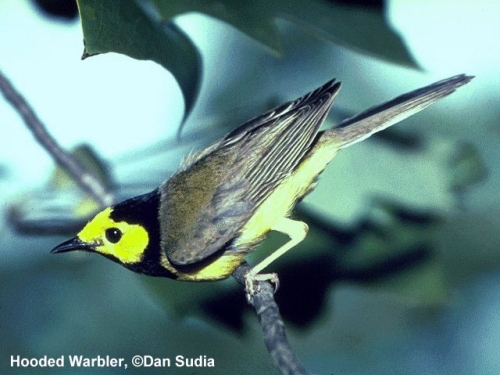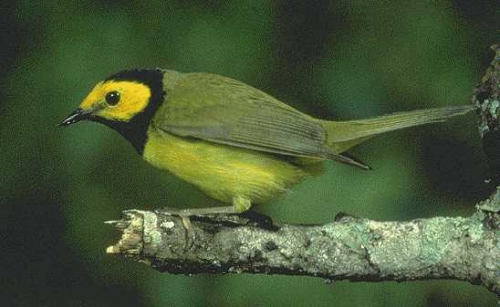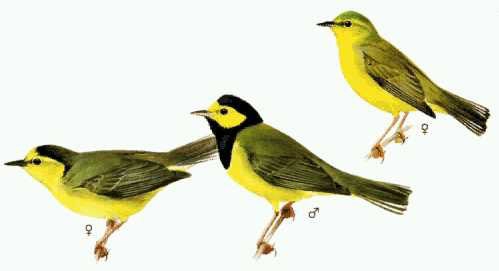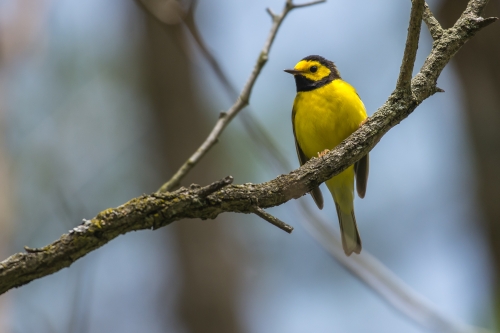Plants and Animals
Setophaga citrina Hooded warbler
Key Characteristics
The male Hooded warbler's yellow face framed by a black hood and throat with yellow underparts and olive green upperparts is distinctive. The female has the same yellow and olive green coloration with the hood varying from non-existent to complete like the male's. The song of the male is a loud, clear "tawee tawee tawee-teeoo" or "tew tew tew teew teo twee twee teew".
Status and Rank
US Status: No Status/Not Listed
State Status: SC - Special Concern (rare or uncertain; not legally protected)
Global Rank: G5 - Secure
State Rank: S3 - Vulnerable
Occurrences
| County | Number of Occurrences | Year Last Observed |
|---|---|---|
| Allegan | 4 | 2010 |
| Barry | 2 | 2014 |
| Berrien | 3 | 2017 |
| Calhoun | 2 | 2022 |
| Cass | 3 | 2022 |
| Hillsdale | 1 | 2014 |
| Ionia | 4 | 2021 |
| Jackson | 2 | 2018 |
| Kalamazoo | 7 | 2022 |
| Kent | 2 | 2005 |
| Lake | 1 | 2007 |
| Lapeer | 2 | 2007 |
| Livingston | 4 | 2003 |
| Montcalm | 2 | 2015 |
| Muskegon | 2 | 2003 |
| Oakland | 11 | 2017 |
| Oceana | 1 | 2007 |
| Ottawa | 1 | 2003 |
| St. Clair | 2 | 2011 |
| St. Joseph | 1 | 2009 |
| Tuscola | 1 | 2016 |
| Van Buren | 5 | 2023 |
| Washtenaw | 6 | 2022 |
| Wayne | 1 | 2006 |
Information is summarized from MNFI's database of rare species and community occurrences. Data may not reflect true distribution since much of the state has not been thoroughly surveyed.
Habitat
A species of beech-maple and floodplain forest the Hooded Warbler occurs in the understory of mesic and wet broad-leaved forests. Small saplings of trees such as beech, maple and basswood are the most frequent nest sites, however, shrubs and herbaceous plants can also serve as nest sites.
Natural Community Types
For each species, lists of natural communities were derived from review of the nearly 6,500 element occurrences in the MNFI database, in addition to herbarium label data for some taxa. In most cases, at least one specimen record exists for each listed natural community. For certain taxa, especially poorly collected or extirpated species of prairie and savanna habitats, natural community lists were derived from inferences from collection sites and habitat preferences in immediately adjacent states (particularly Indiana and Illinois). Natural communities are not listed for those species documented only from altered or ruderal habitats in Michigan, especially for taxa that occur in a variety of habitats outside of the state.
Natural communities are not listed in order of frequency of occurrence, but are rather derived from the full set of natural communities, organized by Ecological Group. In many cases, the general habitat descriptions should provide greater clarity and direction to the surveyor. In future versions of the Rare Species Explorer, we hope to incorporate natural community fidelity ranks for each taxon.
Management Recommendations
Hooded warblers nest in a variety of forest types that all have a mature forest canopy and a dense understory of small trees and shrubs. Management should focus on preserving these characteristics in large contiguous blocks to reduce the threat of brood parasitism by Brown-headed cowbirds and nest predation by small mammals like raccoons. Occasionally overstory trees may be selectively logged to encourage shrub or sapling growth, where the birds nest, but this activity should be conducted in the fall or winter when the warblers are on their wintering grounds to avoid direct impacts to nesting birds.
Active Period
Migration from third week of April to first week of May
Migration from third week of August to fourth week of September
Nesting from first week of May to fourth week of June
Survey Methods
Conduct point counts or meander searches in suitable habitat listening for the distinctive song. Random meander search covers areas that appear likely to have rare taxa, based on habitat and the judgment of the investigator.
Meander search or point count
Survey Period: From first week of May to fourth week of June
Time of Day: Morning (sunrise)
References
Survey References
- Bibby, C.J., N.D. Burgess, and D.A. Hill. 1992. Bird Census Techniques. Academic Press, New York.
Technical References
- Dunn, J. and K. Garrett. A Field Guide to Warblers of North America. Houghton Mifflin, Boston. 672pp.





